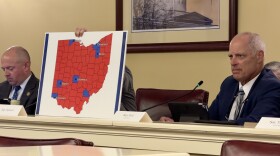If a bipartisan congressional map isn’t adopted by the Ohio Redistricting Commission by the end of this week, state lawmakers could adopt a partisan map without a single Democratic vote next month. Much of what happens after that is speculation. But it could lead to a ballot battle next year.
Senate Minority Leader Nickie Antonio (D-Lakewood) said she has talked to U.S. House Minority Leader Hakeem Jeffries (D-NY) about a possible vote on the process if a partisan congressional map passes next month.
“He has indicated the support from the DNC, the national folks would be there should Ohio have to move forward with a referendum," Antonio said.
That could mean a second vote on a redistricting-related issue in two years. Voters last year rejected a constitutional amendment to create an independent commission of non-politicians to draw maps. A possible repeal next year would affect only a congressional map passed this year, and wouldn't change the redistricting process itself.
Putting forward a referendum is complicated and costly. Once the General Assembly passes a map by Nov. 30, the clock would start ticking. A referendum would require voter signatures to be collected and would require jumping through various hoops. That's where organization and money is particularly important.
Is a referendum possible?
A ballot issue to repeal a state law hasn't happened often. One of the best-known recent ones was Issue 2 in 2011, which sought to repeal Senate Bill 5. That law limited collective bargaining rights of public sector unions such as police and teachers. Unions launched a record-setting signature gathering drive, and voters overturned the law by a wide margin.
A referendum to repeal a map hasn't happened in recent history. Christopher Devine, University of Dayton Associate Professor of Political Science, said there are questions about how that would or could work. He said the provisions baked into the redistricting process were meant to encourage bipartisan maps. But Devine said those guardrails aren’t doing their jobs.
“That system largely has failed," Devine said. "If it was working as intended, we would be getting ten-year, bipartisan maps."
Devine said part of the problem is that voters haven't really held lawmakers accountable when they produce partisan maps: “If there’s no reason to believe that is going to cost you your seat, then legislators in some cases are going to say, what do I have to lose?”
The earliest voters could see a referendum on a map—if it happens—would be November 2026.





